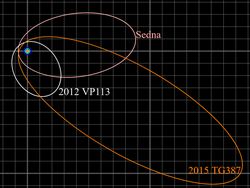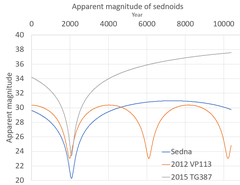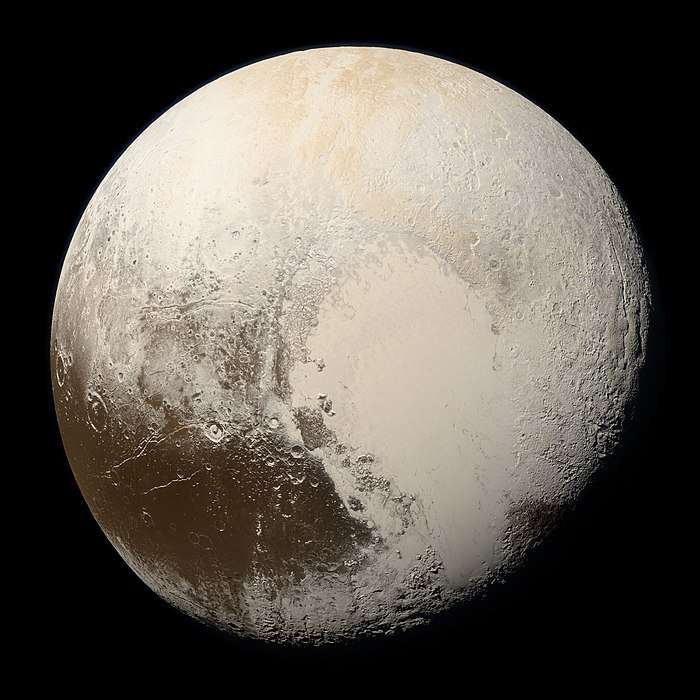Sednoid
A sednoid is a trans-Neptunian object with a perihelion greater than 50 AU and a semi-major axis greater than 150 AU.[1][2] Only three objects are known from this population: 90377 Sedna, 2012 VP113, and 541132 Leleākūhonua, but it is suspected that there are many more. All of them have perihelia greater than 64 AU.[3] These objects lie outside an apparently nearly empty gap in the Solar System starting at about 50 AU, and have no significant interaction with the planets. They are usually grouped with the detached objects. Some astronomers, such as Scott Sheppard,[4] consider the sednoids to be inner Oort cloud objects (OCOs), though the inner Oort cloud, or Hills cloud, was originally predicted to lie beyond 2,000 AU, beyond the aphelia of the three known sednoids.
 The orbits of the three known sednoids with Neptune's 30 AU circular orbit is in blue. |
 The apparent magnitudes of the three known sednoids. |
This definition also applies for 2013 SY99 which has a perihelion at 50.02 AU, far beyond the Kuiper cliff, but it is thought not to belong to the Sednoids, but to the same dynamical class as 2004 VN112, 2014 SR349 and 2010 GB174.[5] With these high eccentricities > 0.8 they can easily be distinguished from the high-perihelion objects with moderate eccentricities which are in a stable resonance with Neptune, that is 2015 KQ174, 2015 FJ345, 2004 XR190, 2014 FC72 and 2014 FZ71.[6]
Unexplained orbits
The sednoids' orbits cannot be explained by perturbations from the giant planets,[7] nor by interaction with the galactic tides.[1] If they formed in their current locations, their orbits must originally have been circular; otherwise accretion (the coalescence of smaller bodies into larger ones) would not have been possible because the large relative velocities between planetesimals would have been too disruptive.[8] Their present elliptical orbits can be explained by several hypotheses:
- These objects could have had their orbits and perihelion distances "lifted" by the passage of a nearby star when the Sun was still embedded in its birth star cluster.[9][10]
- Their orbits could have been disrupted by an as-yet-unknown planet-sized body beyond the Kuiper belt such as the hypothesized Planet Nine.[11][12]
- They could have been captured from around passing stars, most likely in the Sun's birth cluster.[7][13]
Known members
| Number | Name | Diameter (km) |
Perihelion (AU) | Semimajor axis (AU) | Aphelion (AU) | Heliocentric distance (AU) |
Argument of perihelion (°) | Year discovered (precovered) |
|---|---|---|---|---|---|---|---|---|
| 90377 | Sedna | 995 ± 80 | 76.06 | 506 | 936 | 85.1 | 311.38 | 2003 (1990) |
| 2012 VP113 | 300–1000[15] | 80.50 | 261.00 | 441.49 | 83.65 | 293.78 | 2012 (2011) | |
| 541132 | Leleākūhonua | 110[16] | 64.94 | 1094 | 2123 | 77.69 | 118.17 | 2015 (none) |
The three published sednoids, like all of the more extreme detached objects (objects with semi-major axes > 150 AU and perihelia > 30 AU; the orbit of Neptune), have a similar orientation (argument of perihelion) of ≈ 0° (338°±38°). This is not due to an observational bias and is unexpected, because interaction with the giant planets should have randomized their arguments of perihelion (ω),[1] with precession periods between 40 Myr and 650 Myr and 1.5 Gyr for Sedna.[13] This suggests that one[1] or more[17] undiscovered massive perturbers may exist in the outer Solar System. A super-Earth at 250 AU would cause these objects to librate around ω = 0°±60° for billions of years. There are multiple possible configurations and a low-albedo super-Earth at that distance would have an apparent magnitude below the current all-sky-survey detection limits. This hypothetical super-Earth has been dubbed Planet Nine. Larger, more-distant perturbers would also be too faint to be detected.[1]
As of 2016, 27 known objects have a semi-major axis greater than 150 AU, a perihelion beyond Neptune, an argument of perihelion of 340°±55°, and an observation arc of more than 1 year.[18] 2013 SY99 is near the limit of perihelion of 50 AU, but is not considered a sednoid.
On 1 October 2018, Leleākūhonua, then known as 2015 TG387, was announced with perihelion of 65 AU and a semimajor axis of 1094 AU. With an aphelion over 2100 AU, it brings the object further out than Sedna.
In late 2015, V774104 was announced at the Division for Planetary Science conference as a further candidate sednoid, but its observation arc was too short to know whether its perihelion was even outside Neptune's influence.[19] The talk about V774104 was probably meant to refer to Leleākūhonua (2015 TG387) even though V774104 is the internal designation for non-sednoid 2015 TH367.
Sednoids might constitute a proper dynamical class, but they may have a heterogeneous origin; the spectral slopes of (474640) 2004 VN112, 2013 RF98, 2012 VP113, 2002 GB32 and 2003 HB57 are very different from that of 90377 Sedna.[20]
Theoretical population
Each of the proposed mechanisms for Sedna's extreme orbit would leave a distinct mark on the structure and dynamics of any wider population. If a trans-Neptunian planet were responsible, all such objects would share roughly the same perihelion (≈80 AU). If Sedna had been captured from another planetary system that rotated in the same direction as the Solar System, then all of its population would have orbits on relatively low inclinations and have semi-major axes ranging from 100–500 AU. If it rotated in the opposite direction, then two populations would form, one with low and one with high inclinations. The perturbations from passing stars would produce a wide variety of perihelia and inclinations, each dependent on the number and angle of such encounters.[21]
Acquiring a larger sample of such objects would therefore help in determining which scenario is most likely.[22] "I call Sedna a fossil record of the earliest Solar System", said Brown in 2006. "Eventually, when other fossil records are found, Sedna will help tell us how the Sun formed and the number of stars that were close to the Sun when it formed."[23] A 2007–2008 survey by Brown, Rabinowitz and Schwamb attempted to locate another member of Sedna's hypothetical population. Although the survey was sensitive to movement out to 1,000 AU and discovered the likely dwarf planet Gonggong, it detected no new sednoids.[22] Subsequent simulations incorporating the new data suggested about 40 Sedna-sized objects probably exist in this region, with the brightest being about Eris's magnitude (−1.0).[22]
Following the discovery of Leleākūhonua, Sheppard et al. concluded that it implies a population of about 2 million Inner Oort Cloud objects larger than 40 km, with a total mass in the range of 1×1022 kg (several times the mass of the asteroid belt and 80% the mass of Pluto).[24]
References
- Trujillo, Chadwick A.; Sheppard, Scott S. (2014). "A Sedna-like body with a perihelion of 80 astronomical units" (PDF). Nature. 507 (7493): 471–474. Bibcode:2014Natur.507..471T. doi:10.1038/nature13156. PMID 24670765. Archived (PDF) from the original on 2014-12-16.
- Sheppard, Scott S. "Known Extreme Outer Solar System Objects". Department of Terrestrial Magnetism, Carnegie Institution for Science. Retrieved 2014-04-17.
- "JPL Small-Body Database Search Engine: a > 150 (AU) and q > 50 (AU) and data-arc span > 365 (d)". JPL Solar System Dynamics. Retrieved 2014-10-15.
- Sheppard, Scott S. "Beyond the Edge of the Solar System: The Inner Oort Cloud Population". Department of Terrestrial Magnetism, Carnegie Institution for Science. Retrieved 2014-04-17.
- Bannister, Michele; Shankman, Cory; Volk, Katherine (2017). "OSSOS: V. Diffusion in the orbit of a high-perihelion distant Solar System object". The Astronomical Journal. 153 (6): 262. arXiv:1704.01952. Bibcode:2017AJ....153..262B. doi:10.3847/1538-3881/aa6db5.
- Sheppard, Scott S.; Trujillo, Chadwick; Tholen, David J. (July 2016). "Beyond the Kuiper Belt Edge: New High Perihelion Trans-Neptunian Objects with Moderate Semimajor Axes and Eccentricities". The Astrophysical Journal Letters. 825 (1). L13. arXiv:1606.02294. Bibcode:2016ApJ...825L..13S. doi:10.3847/2041-8205/825/1/L13.
- Brown, Michael E.; Trujillo, Chadwick A.; Rabinowitz, David L. (2004). "Discovery of a Candidate Inner Oort Cloud Planetoid" (PDF). Astrophysical Journal. 617 (1): 645–649. arXiv:astro-ph/0404456. Bibcode:2004ApJ...617..645B. doi:10.1086/422095. Archived from the original (PDF) on 2006-06-27. Retrieved 2008-04-02.
- Sheppard, Scott S.; Jewitt, David (2005). "Small Bodies in the Outer Solar System" (PDF). Frank N. Bash Symposium. University of Texas at Austin. Retrieved 2008-03-25.
- Morbidelli, Alessandro; Levison, Harold (2004). "Scenarios for the Origin of the Orbits of the Trans-Neptunian Objects 2000 CR105 and 2003 VB12 (Sedna)". Astronomical Journal. 128 (5): 2564–2576. arXiv:astro-ph/0403358. Bibcode:2004AJ....128.2564M. doi:10.1086/424617.
- Pfalzner, Susanne; Bhandare, Asmita; Vincke, Kirsten; Lacerda, Pedro (2018-08-09). "Outer Solar System Possibly Shaped by a Stellar Fly-by". The Astrophysical Journal. 863 (1): 45. arXiv:1807.02960. doi:10.3847/1538-4357/aad23c. ISSN 1538-4357.
- Gomes, Rodney S.; Matese, John J.; Lissauer, Jack J. (2006). "A distant planetary-mass solar companion may have produced distant detached objects". Icarus. 184 (2): 589–601. Bibcode:2006Icar..184..589G. doi:10.1016/j.icarus.2006.05.026.
- Lykawka, Patryk S.; Mukai, Tadashi (2008). "An outer planet beyond Pluto and the origin of the trans-Neptunian belt". Astronomical Journal. 135 (4): 1161–1200. arXiv:0712.2198. Bibcode:2008AJ....135.1161L. doi:10.1088/0004-6256/135/4/1161.
- Jílková, Lucie; Portegies Zwart, Simon; Pijloo, Tjibaria; Hammer, Michael (2015). "How Sedna and family were captured in a close encounter with a solar sibling". MNRAS. 453 (3): 3158–3163. arXiv:1506.03105. Bibcode:2015MNRAS.453.3157J. doi:10.1093/mnras/stv1803.
- "MPC list of q > 50 and a > 150". Minor Planet Center. Retrieved 1 October 2018.
- Lakdawalla, Emily (26 March 2014). "A second Sedna! What does it mean?". Planetary Society blogs. The Planetary Society. Retrieved 12 June 2019.
- Buie, Marc W.; Leiva, Rodrigo; Keller, John M.; Desmars, Josselin; Sicardy, Bruno; Kavelaars, J. J.; et al. (April 2020). "A Single-chord Stellar Occultation by the Extreme Trans-Neptunian Object (541132) Leleākūhonua". The Astronomical Journal. 159 (5). Bibcode:2020AJ....159..230B. doi:10.3847/1538-3881/ab8630. 230.
- de la Fuente Marcos, Carlos; de la Fuente Marcos, Raúl (1 September 2014). "Extreme trans-Neptunian objects and the Kozai mechanism: signalling the presence of trans-Plutonian planets". Monthly Notices of the Royal Astronomical Society: Letters. 443 (1): L59–L63. arXiv:1406.0715. Bibcode:2014MNRAS.443L..59D. doi:10.1093/mnrasl/slu084.
- "JPL Small-Body Database Search Engine: a > 150 (AU) and q > 30 (AU) and data-arc span > 365 (d)". JPL Solar System Dynamics. Retrieved 2016-02-08.
- Witze, Alexandra (2015-11-10). "Astronomers spy most distant Solar System object ever". Nature News. doi:10.1038/nature.2015.18770.
- de León, Julia; de la Fuente Marcos, Carlos; de la Fuente Marcos, Raúl (May 2017). "Visible spectra of (474640) 2004 VN112-2013 RF98 with OSIRIS at the 10.4 m GTC: evidence for binary dissociation near aphelion among the extreme trans-Neptunian objects". Monthly Notices of the Royal Astronomical Society: Letters. 467 (1): L66–L70. arXiv:1701.02534. Bibcode:2017MNRAS.467L..66D. doi:10.1093/mnrasl/slx003.
-
Schwamb, Megan E. (2007). "Searching for Sedna's Sisters: Exploring the inner Oort cloud" (PDF). Caltech. Archived from the original (PDF) on 2013-05-12. Retrieved 2010-08-06. Cite journal requires
|journal=(help) - Schwamb, Megan E.; Brown, Michael E.; Rabinowitz, David L. (2009). "A Search for Distant Solar System Bodies in the Region of Sedna". The Astrophysical Journal Letters. 694 (1): L45–L48. arXiv:0901.4173. Bibcode:2009ApJ...694L..45S. doi:10.1088/0004-637X/694/1/L45.
- Fussman, Cal (2006). "The Man Who Finds Planets". Discover. Archived from the original on 16 June 2010. Retrieved 2010-05-22.
- Scott Sheppard; Chadwick Trujillo; David Tholen; Nathan Kaib (1 October 2018). "A New High Perihelion Inner Oort Cloud Object". arXiv:1810.00013. doi:10.3847/1538-3881/ab0895. Cite journal requires
|journal=(help)
External links

- New icy body hints at planet lurking beyond Pluto
_(cropped).jpg)
